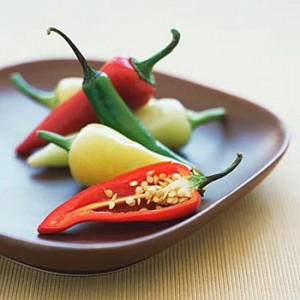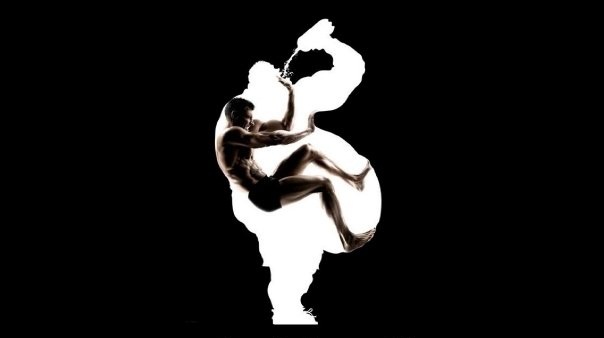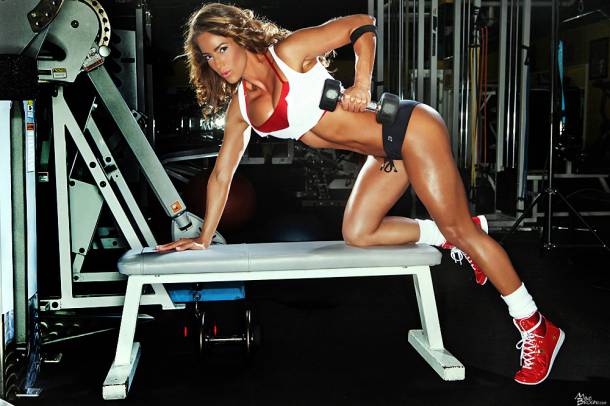Life, they say, is full of contradictions, so why shouldn’t that also apply to working out? You train regularly with both weights and cardio and carefully watch what you eat, which together are supposed to produce a ripped, muscular physique.
There’s the catch: supposed to. But what if you do practically everything you can truly giving 110% to your training and nutrition efforts and you’re still a little soft around the middle? Are you forever doomed to wearing tank tops on warm summer days so friends can see your big guns without knowing there’s an inch to pinch?

This being SimplyShredded.com, we’re not going to recommend an expensive liposuction operation. (Unless, of course, your beloved and rich Uncle Fred left you with several hundred thousand dollars, in which case you can skip this article and call your plastic surgeon.) Rather, we’ve complied a series of tips, tweaks and techniques for you to add to what you’re already doing during the course of a day. Instead of asking you to drop your workouts and follow some one-size-fits-all program, we’ve come up with a list of ways you can increase your caloric deficit each day.

All of the tips presented here use one or more of three bodyfat-fighting strategies: reducing the amount of food you eat (the calories you take in), increasing the amount of exercise you perform (the calories you burn) and boosting your metabolic rate (the number of calories your body requires for body weight maintenance).
Added together, these tips and strategies could theoretically help you synergistically burn up to 3,650 calories a day, but most individuals will want to pick and choose items that allow them to burn up to 1,500 calories* a day without requiring a significant change to diet or training regimen. You can still perform the same weight-training exercises and routines just add our training and nutrition tips to the mix.
1) Add Intervals To Your Cardio Work
The Caloric Effect: 150 calories
“Interval training burns more calories than steady-state training because you can do more work in the same amount of time,” says Tom Seabourne, who has a PhD in exercise science and is author of Athletic Abs with Scott Cole (Human Kinetics, 2002). To use this calorie-burning technique, Seabourne suggests that you include sprints with your jogging, add jogging to your fast-paced walking or increase the difficulty level or pace when using cardio equipment. “Add 60 seconds of interval training every other minute or so. The harder you work, the more calories you’ll burn,” Seabourne advises.
Comment: Not only do you burn more calories during these intense interval cycles, but they also rev up your calorie-burning during the hours following your training.
2) Increase Your Weights By 5%-10%

The Caloric Effect: 500-600 calories
“This technique shakes up your workout,” says Steve Zim, fitness expert for NBC’s Weekend Today. “A lot of people get stuck using the same weights and reps over and over. Their bodies acclimate to the workload, and they don’t burn as many calories as they would if they provided their body with unexpected stimulation.” Increasing your training weights 5%-10% is a great way to do this.
Comment: Research shows that heavy training (in the 6-8-rep range) increases metabolic rate over the subsequent two days, helping you burn up to 600 calories more than after lightweight training (12-15-rep range). In addition, by raising your weight just 5%, you may find yourself more inspired, encouraging you to work harder and burn even more calories.
3) Mix Up Your Cardio
The Caloric Effect: 50-100 calories
Got a favorite cardio machine in the gym? Ditch it. You may be surprised by how much more beneficial cross-training is vs. performing the same exercise during every cardio session. “When you include a variety of cardio machines in your routines treadmill, stationary bike, elliptical, cross-country ski machine, stair-stepper you stimulate the same muscles in new ways or even work different muscle groups. The more groups you use that are unaccustomed to training, the harder you must work at an exercise, thus you burn more calories,” says Seabourne.
Comment: Use your heart rate as a guide to ensure that you achieve the same level of intensity on different pieces of equipment. Some machines feel more difficult than others, even if they’re set at a level below where you should be training.
4) Avoid Consecutive Days Of Rest

The Caloric Effect: 250-500 calories
“Try to avoid taking more than one rest day at a time,” Zim says. “You need a rest day after every 3-4 days of training in a row, but subsequent rest days can begin to lower your metabolic rate.”
Comment: For the best effect on both metabolism and muscle recovery, strive to train three days on, one day off. To keep up your metabolic rate, take off a second or third day only when you feel overtrained or under the weather. Even though you don’t feel like hitting the gym on those days, try doing some kind of aerobic activity for at least 30 minutes.
5) Split Your Workout Into Two
The Caloric Effect: 100-300 calories
“Instead of doing an hour-and-a-half workout in the morning, try doing 45 minutes in the morning and 45 minutes after work,” says Zim. This revs up your metabolic rate twice a day instead of once. During the last half of a long training session, you may work out with less intensity because of fatigue; by splitting your training, you recover enough to burn more calories in your second 45-minute installment.
Comment: Calorie-burning can vary based on your intensity. The effects of two metabolism-boosting sessions will stay with you all day.
6) Eat Spicy Foods

The Caloric Effect: 200-500 calories
The Technique: “Spices such as red pepper and cayenne can significantly crank up your metabolic rate and decrease your overall food intake,” explains Zim.
Comment: The number of calories you burn from this technique is correlated to the amount of low-calorie spices you consume. The more spices you add to your food, the greater their effect on your metabolic rate.
7) Record The Food You Eat
The Caloric Effect: 300-500 calories
Keeping a food journal can have a surprising effect on your discipline, because it makes you think about everything you put into your mouth. Just by committing to write down all the food you eat, you’re less likely to include unhealthy foods in your diet.
Comment: Whether this has a minimal or profound psychological effect on you, it provides you with valuable information about your nutritional habits.
8) Cut Out All Caloric Beverages
The Caloric Effect: 50-500 calories
 Eat your calories instead of drinking them. Ingesting more liquid calories is a good weight-gaining strategy because they’re easier to consume when you don’t have an appetite. On the flip side, liquid calories don’t satisfy you as much as solid foods. Sodas, milk, juice, sugar added to drinks such as coffee or tea and other caloric beverages are a significant source of calories for many people. Try drinking only water, plain tea, black coffee or diet (no-calorie) beverages for a couple of weeks and see if you notice a difference in your bodyfat stores.
Eat your calories instead of drinking them. Ingesting more liquid calories is a good weight-gaining strategy because they’re easier to consume when you don’t have an appetite. On the flip side, liquid calories don’t satisfy you as much as solid foods. Sodas, milk, juice, sugar added to drinks such as coffee or tea and other caloric beverages are a significant source of calories for many people. Try drinking only water, plain tea, black coffee or diet (no-calorie) beverages for a couple of weeks and see if you notice a difference in your bodyfat stores.
Comment: The caloric effect depends on how many calories you consume in liquid form. Be careful if you typically get a lot of your protein from milk and protein shakes you’ll need to consume this nutrient in different ways.
9) Drink Green Tea & Black Coffee
The Caloric Effect: 50-200 calories
When you drink green tea and coffee, you may notice the energizing effect they have on your body. “Green tea and black coffee also boost your metabolism without adding significant calories to your diet,” says Zim. In addition, these caffeinated beverages tend to reduce appetite, helping you further cut calorie consumption.
Comment: While the metabolic boost from caffeine is small, the decrease in calories consumed can be significant.
10) Reduce Carbs Later In The Day
The Caloric Effect: 200-300 calories
Cutting back on carbs during the later part of the day is smart for two reasons: One, you decrease the number of calories you consume each day, and two, you reduce the amount of insulin your body must produce, which decreases the amount of fat your body stores. You don’t need to eliminate pasta or potatoes, but cut back on them late in the day, eating one-third to one-half of your normal servings.
Comment: Pro body-builders know this is one of the most significant ways to reduce stored bodyfat. But if you train late in the day, get some carbs after your workout to replenish muscle glycogen stores.
Notes:
Number of calories burned is based on a 200-pound man who exercises four times a week and currently consumes enough calories for bodyweight maintenance. The total number of calories you burn will likely vary.
The “Do NOT Do” List To Getting Shredded (Bonus Article)
We always tell you what to do to change the way your body looks, but if you’re looking to get lean, you should also know what habits to avoid!

Each month, we update you with fitness and nutrition “must dos” to educate you and keep you on the right track, but sometimes the best way to develop good habits is by learning what not to do. If you’re looking to shed some bodyfat, there are some very basic guidelines anyone can follow to start achieving results. For some reason, however, there are still those who make a few cardinal mistakes. Here we explain the 1o things you absolutely should not do if you want to get lean. If you’re doing any of them, your physique is in big trouble. Now go to you room and read.
Sticking to light weights and high reps

“Heavy weight just bulks you up,” says the shapeless gym enthusiast. “Lighter weights with higher reps is what really gets you ripped.” Tsk, tsk tsk. Mr. Nonsense and his amoebic physique have good intentions, but this way of thinking is as archaic as eight-track cassettes.
High-rep sets definitely have their place increasing muscular endurance and pump, for instance but they should never from the backbone of your program when you’re trying to get lean. Sticking to lightweight sets (12-20 reps) for an extended period robs you muscles of what they need most a constant challenge. In the absence of new stimuli, such as constantly increasing weight loads, your muscles will simply grow content and either plateau or backtrack in size and shape. Lifting heavier will help you gain more lean tissue, which allows you to be slightly more metabolic at rest. Plus, heavy training (6-8 reps) increases the total caloric expenditure during and after your workout.
Best Tip
Base you program on heavy, multi joint lifts such as squats, deadlifts and various presses that recruit and build more total muscle and burn more calories. Use moderate (10-12 reps) and lightweight (12-20 reps) sets to complement your heavy training, not the other way around.
Performing cardio before weight training
Some silly folks like to shamelessly exploit a fundamental training mantra that you should always train for priorities. If losing bodyfat is your primary goal, for example, then cardio should be your primary focus in the gym, right? This is one case where your priorities are just backward, pal. While cardio by itself is certainly productive, doing cardio after your weight-training session is almost twice as productive at burning fat.
Research
Japanese researchers recently determined that doing a weight workout before cardio resulted in significantly more fat-burning than doing cardio alone. In the study, a cardio-only group burned just more than 20% of their total calories from fat, while another group who did cardio after weights burned nearly 50% of their total calories from fat. One reason for this amazing disparity is that the body plows through stored glycogen during your weight routine, making fat the primary fuel source once it’s time for your cardio.
Best Tip
Perform cardio when it’ll be most productive for you after you hit the weights. Try mixing in 3-4, 20-30- minute, postlifting cardio sessions per week.
Eating fast-digesting carbs preworkout
 Before you hit the gym, you definitely want to have some protein, but some people still reach for white toast, Gatorade and other fast-digesting carbs to round out their preworkout meal. Somewhere on a cave wall it is written in ancient Sanskrit: A crab is a carb is a carb. Today, we know better. Your definitely don’t want to head to the gym on an empty tank, which is why you should fuel up in the 60-90 minutes or so before your first rep.
Before you hit the gym, you definitely want to have some protein, but some people still reach for white toast, Gatorade and other fast-digesting carbs to round out their preworkout meal. Somewhere on a cave wall it is written in ancient Sanskrit: A crab is a carb is a carb. Today, we know better. Your definitely don’t want to head to the gym on an empty tank, which is why you should fuel up in the 60-90 minutes or so before your first rep.
But before you guzzle a sports drink or have a baked potato, know this: Fast-digesting carbs will have a negative impact on your body’s ability to burn fat for fuel in the gym because they boost insulin. This anabolic hormone is great to boost after the workout for encouraging muscle growth, but during the workout it blunts fat-burning.
Best Tip
While having some carbs in your system is ideal preworkout, you’ll want to make smarter choices to keep your fat-burning high. Take in 30-40 grams of slower-digesting sources such as oatmeal, whole-grain bread, fruit or sweet potatoes 15-30 minutes before training. Research shows that athletes who eat these foods burn more fat.
Always doing steady-state cardio at 70%-80% of max heart rate (MHR)
We love those skinny dudes who hit the treadmill with a heart-mate monitor strapped around their chests it helps round out their already stylish headband-and-Adidas Gazalles look. But that leisurely prance is simply no match for a hard-sweat, fat nuking interval session. Steady-state cardio done at 70%-80% of your max heart rate will definitely eat away at bodyfat, but you may be selling yourself short.
Your best bet is to train using intervals, where you frequently alternate between bouts of high intensity (80%-90% MHR) and low intensity (50%-60% MHR). This method of training leaves the body burning more fat long after you put in you last sprint no heart rate monitor required.
Best Tip
Perform 20-30 minutes of interval training on a treadmill, elliptical or bike 2-3 times per week. Try one minute of high intensity (a fast run) followed by bone minute of low intensity (a slow walk) and keep repeating.
Avoiding caffeine, green tea and carnitine
 Men. We’re too proud to ask for directions, sure. That’s because our navigational prowess makes it unnecessary for us to do so. But we’re here to tell you that refusing to sue supplements to power your fat fighting efforts could leave you feeling as though you’re driving in circles. When it comes to shedding bodyfat, there’s no substitute for hard training and sound dieting. But that doesn’t mean you shouldn’t use everything at your disposal to speed up you results. Virtually every fat-burner on the market contains some form of caffeine, green tea or carnitine. Why? All three attack fat-burning from different sides, making your training and nutritional efforts all the more productive.
Men. We’re too proud to ask for directions, sure. That’s because our navigational prowess makes it unnecessary for us to do so. But we’re here to tell you that refusing to sue supplements to power your fat fighting efforts could leave you feeling as though you’re driving in circles. When it comes to shedding bodyfat, there’s no substitute for hard training and sound dieting. But that doesn’t mean you shouldn’t use everything at your disposal to speed up you results. Virtually every fat-burner on the market contains some form of caffeine, green tea or carnitine. Why? All three attack fat-burning from different sides, making your training and nutritional efforts all the more productive.
Caffeine binds to fat cells to enhance fat-burning during exercise, green tea prevents the breakdown of the metabolism-regulation neurotransmitter norepinephrine and carnitine helps transport fat into the mitochondria of cells, where they’re burned for energy. Avoiding these supps is an easy way to downshift your progress.
Best Tip
Take 200-400 mg of caffeine with breakfast and 200-400 mg 1-2 hours before your workout. Take 500 mg of green tea extract three times a day, including one serving just before your workout. Take 1-2 grams of carnitine three times a day, including one serving just before and one serving immediately after your workout.
Avoiding protein or amino acids before cardio
If you’re a reader of Simplyshredded, you should know just how important pre and post workout nutrition and supplementation is. It’s easy to eat like a maniac after a hard workout, but some guys miss the mark when it comes to the pre-workout prep, particularly in terms of halting muscle catabolism on a cardio-only day. What a shame, because it’s an easy fix.
Leaning out isn’t nearly as fun unless you have some muscle underneath that blubber. So before hitting the treadmill Maurice Greene-style, make sure you’ve primed your body to hold on to as much muscle as possible. Taking 10-20 grams of fast-digesting whey protein or 3-6 grams of amino acids before a hard cardio session particularly those done in the morning on a empty stomach will help ensure that your body has available energy for the work ahead rather than tapping into muscle protein.
Best Tip
Take 3-6 grams of amino acids or consume a light, 10-20 gram whey protein shake before cardio. This is especially important for cardio before breakfast.

Eating three squares a day
We don’t blame you entirely for this one. The whole, “breakfast, lunch and dinner” approach to nutrition has been an American mainstay seemingly since time began. It has worked wonders, too, what with us Yanks now in the midst of a national obesity epidemic. This philosophy works for our armed forces, but unless you’re doing 8-mile hikes with a 70-pound rucksack twice a day, you’re better off consuming 5-6 small meals a day. While some people rely on three squares to meet their daily caloric needs, such large infrequent meals can cause stomach bloating, overeating, drops in blood sugar and greater fat retention.
Smaller, more frequent meals keep your metabolism higher, allowing your body to use more of the food for fuel instead of dropping it off on your waistline.
Best Tip
Even if you’re chained to a desk for 10 hours a day, make sure your consume small meals or snacks every 2-3 hours. Protein powders, canned tuna, nuts, jerky, fruit and protein bars are all good things to keep on hand.
Sticking to straight sets in the gym
 Three sets of 10 on every exercise, 1-2 minutes of rest between sets, huh? Yawn. How long have you been doing that, and how much has it helped you lean out? If you’re reading this, the answers are probably, “too long” and, “not much.” If your really want to blast away at stubborn fat stores, you need to kick things up a notch. Supersets are a perfect way to do that. Performing two or more exercises back-to-back without rest can boost pos-workout growth hormone levels, thus increasing muscle mass and stoking fat-burning without really increasing your workout volume.
Three sets of 10 on every exercise, 1-2 minutes of rest between sets, huh? Yawn. How long have you been doing that, and how much has it helped you lean out? If you’re reading this, the answers are probably, “too long” and, “not much.” If your really want to blast away at stubborn fat stores, you need to kick things up a notch. Supersets are a perfect way to do that. Performing two or more exercises back-to-back without rest can boost pos-workout growth hormone levels, thus increasing muscle mass and stoking fat-burning without really increasing your workout volume.
Plus, moving from one exercise to another with limited rest in between increases your calories burned during exercises.
Best Tip
Try using an all-supersets workout for 2-4 weeks to elevate your metabolism, burn more calories and boost GH levels.
Eating carbs alone
Even the most dedicated, carb-deprived bodybuilders need the occasional carb-heavy snack to keep their sanity intact. So if your diet makes you feel as if you need to chow down on a plain bagel from time to time, feel free to do so. Just don’t have it alone! If you eat carbs by themselves, particularly outside of training times, you might as well start shopping for wider-waisted jeans.
It’s okay to have carbs when trying to get lean just make sure you have some protein, too. An extra glass of milk, some egg whites or some cottage cheese are all suitable items to add to a carb-rich dish. The addition of protein will help slow the digestion of carbs, keeping your body form storing them as fat.
Best Tip
Never eat carbs alone. Always have them with protein and small amounts of fat to slow digestion and keep your blood sugar levels in check. Eating fibrous veggies such as broccoli, cauliflower and green beans helps ensure slower digestion of all carbohydrates.
Being a night owl
We known how it is. After a hard day’s night at the gym, you like to come home, refuel with food, plop down on the couch and take inventory of your DVR list. After your sixth episode of Rescue Me, however, you find that the night has gotten away from you. Is it really 1:15? Your finally commit to exiting your recorded shows when you realize, Hey, that’s Jessica Biel on Late Night with Conan O’Brien! There goes another half-hour. Got to bed already!
Studies have shown that those of us who like to stay up late be it channel surfing, web browsing or just reading and get up early for work suffer the consequences by way of the belly. That’s right getting less sleep actually contributes to higher levels of bodyfat over time.
Best Tip
If you’re looking to drop bodyfat, then you need to manage you time better, especially in the evening.
Wind down after your workout, get to bed at a decent hour and aim to get eight hours of uninterrupted sleep.

Authors: Jim Stoppani & Eric Velazquez
COPYRIGHT 2010 Weider Publications
COPYRIGHT 2010 Gale Group
References:
Choi, Y.M., Suh, H.J. Phytotherapy Research 18(11):884-888, 2004.
Dulloo, A.G., et al. American Journal of Clinical Nutrition 70:1,040-1,045, 1999.
Henning, S.A., et al. American Journal of Clinical Nutrition 80(6):1,558-1,564, 2004.










